Advertisement
Hero Or Killer? Statues Of A Colonial Woman Face A Reckoning
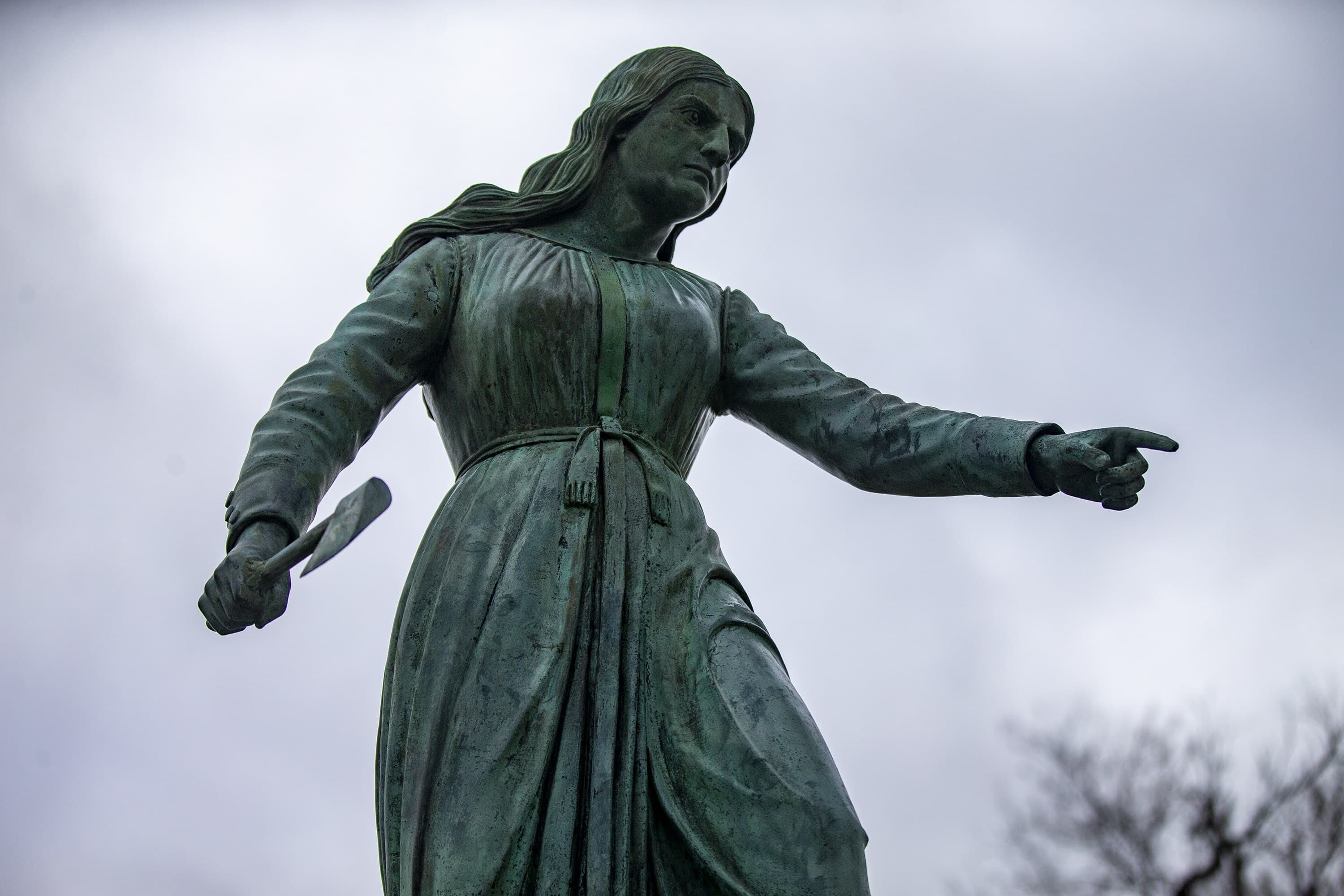
Editor’s Note: This story contains graphic descriptions of violence against children that may be disturbing.
This story has been updated as the Haverhill City Council has voted to keep the statue of Hannah Duston in the park, but alter a portion of the inscription, and remove the hatchet.
In Haverhill, Massachusetts, a statue of a woman towers over a patch of daffodils in the city’s G.A.R. (Grand Army of the Republic) Park. Scowling ferociously, she leans forward, pointing her left hand accusingly. In her right hand she grips a small hatchet.
The statue honors Hannah Duston, a 17th-century English colonist who is believed to have killed 10 Native Americans in order to escape captivity during King William’s War. It, along with a similar statue in Boscawen, New Hampshire, have become flashpoints in the country’s ongoing debate about racist monuments, as locals reevaluate the Duston legend.
“That hatchet is supposedly the one that she actually used to ‘scalp the warriors’,” says Ron Peacetree, of the Haverhill Historical Commission.
Standing in the shadow of the Haverhill statue on a windy spring evening, Peacetree explains how the popular legend — in which Duston acted in self-defense against a group of Native American warriors who had kidnapped her and killed her newborn — is contradicted by historical evidence. A number of Duston's victims were children, he says, not warriors.
Scholars believe that’s because by the time Duston made her escape, she was no longer traveling with her original captors but with a family group — likely Abenaki — made up of two men, three women and seven children. They may have planned to ransom her back to her family, which was a common practice at the time.
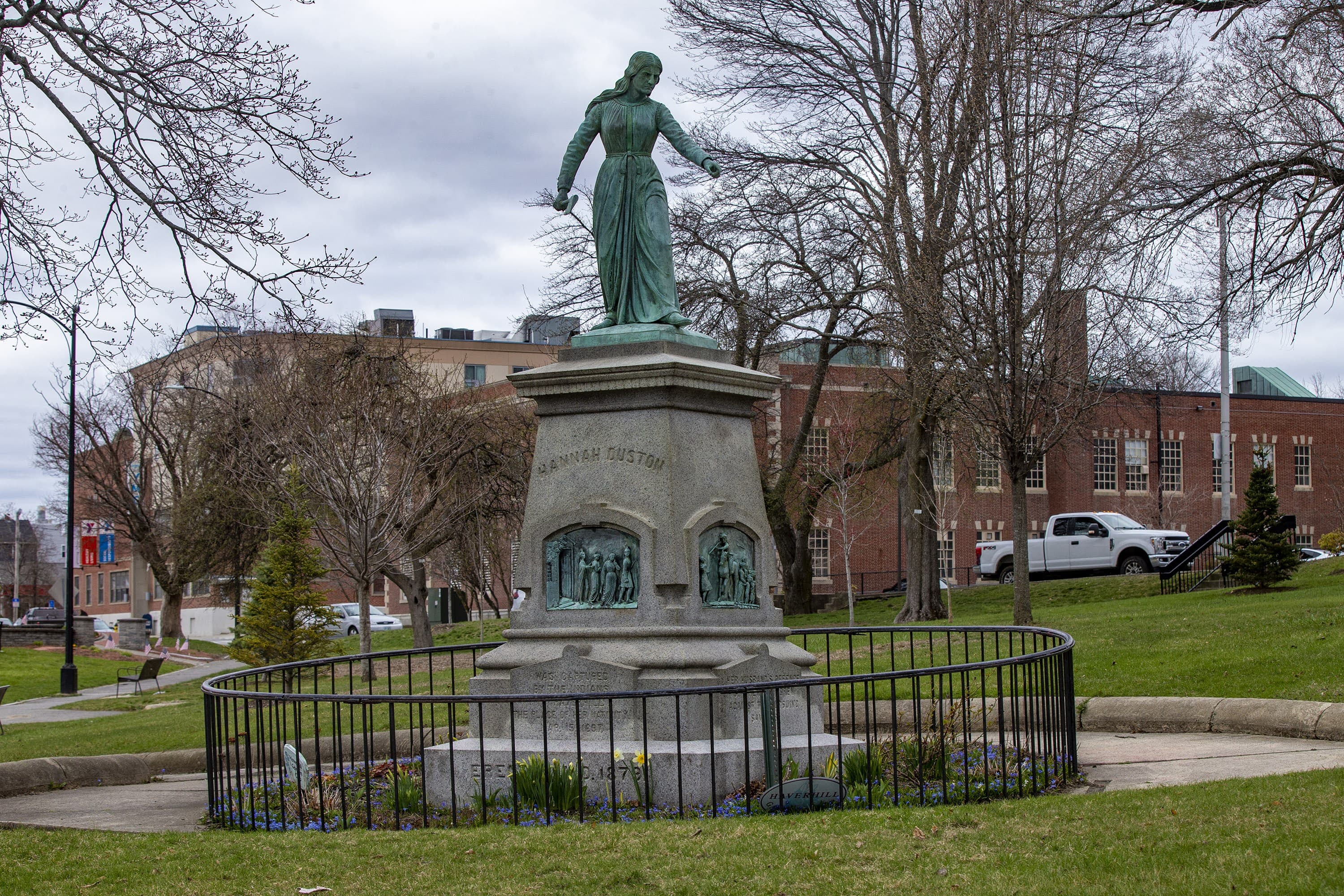
Peacetree has lived in Haverhill for two decades. He is half Haudenosaunee — commonly known as Iroquois — and spent his teenage years on the Saint Regis Mohawk Reservation in upstate New York. He remembers, distinctly, the discrimination he faced growing up in the 1960s, like the time his family was turned away from a hotel.
“[The clerk] looked at my mom and us four kids and said, ‘I'm sorry, we don't serve your kind here. The place you want is two miles down the road’,” Peacetree says. “Thankfully, you can't get away with that anymore. But this [statue] is the roots, part of the foundation, of the philosophy that made that OK.”
Not everyone agrees. “I have no problem celebrating her strength as a woman and her ability and her drive to survive,” says 79-year-old Lou Fossarelli, who grew up in Haverhill and now lives in nearby Newburyport. “And you know what? To seek a little revenge upon someone who really ruined her future and her life.”
The Haverhill monument became the subject of fierce public debate last year in the wake of Black Lives Matter protests and the ensuing scrutiny of Confederate monuments. Haverhill’s mayor, James Fiorentini, appointed two Native Americans (one of them Peacetree) to the The Haverhill Historical Commission and asked the group to make a recommendation about the statue. The commission consulted experts and heard testimony from residents. It ultimately advised that the statue be moved elsewhere, like a museum, where a more nuanced story could be told.
The Haverhill Historical Commission made its recommendation to the City Council last fall. On Tuesday, the Council voted to approve a proposal to keep the statue in the park, but alter some of the inscription, and remove the hatchet.
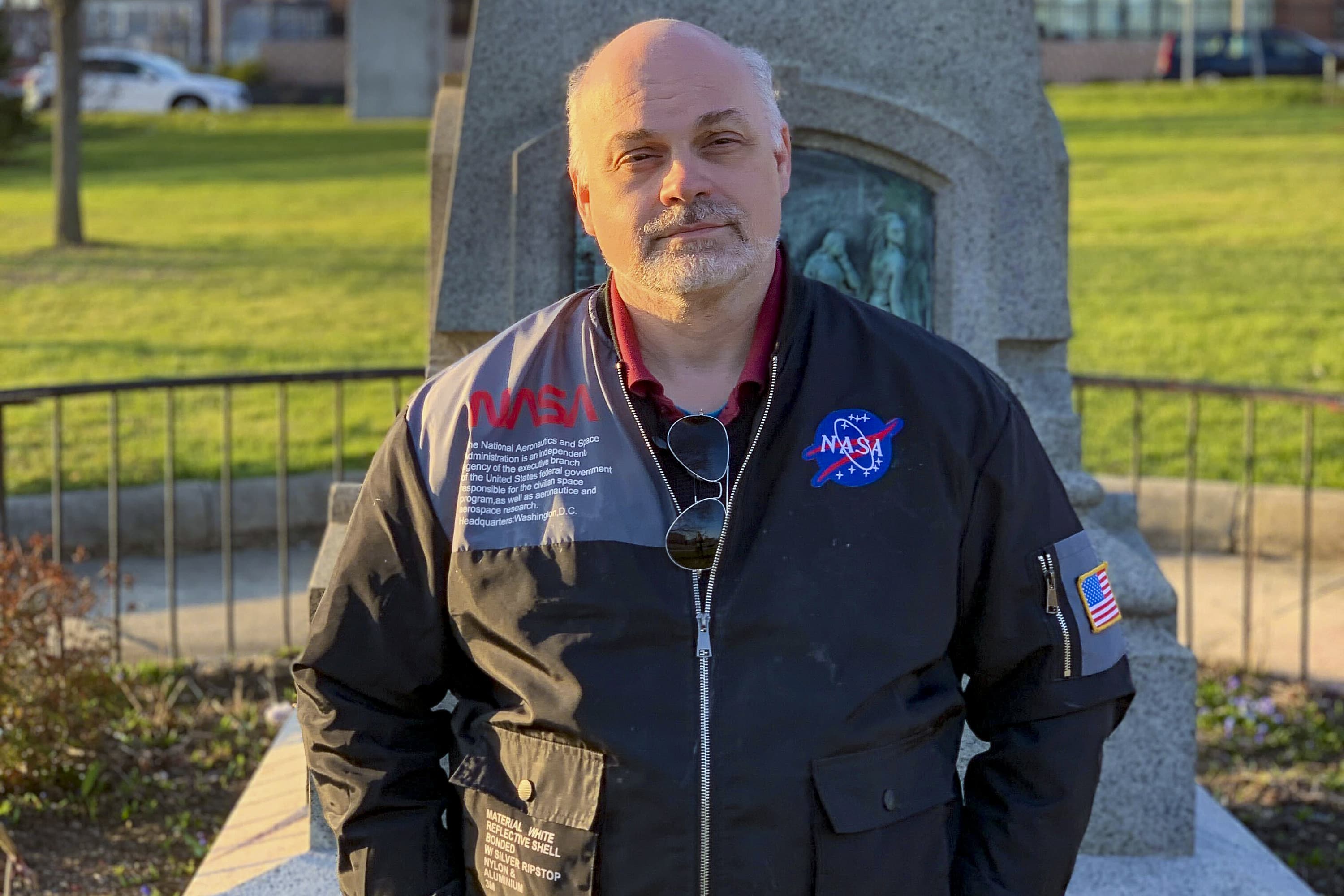
The History Behind The Legend
Hannah Duston was 40 years old when a group of French-aligned Native Americans, likely Abenaki, raided the English settlement of Haverhill on March 15, 1697. Duston’s husband escaped with eight of their children, but Duston and her newborn were captured, along with her nursemaid, Mary Neff. According to some accounts, their captors killed the baby.
The two women were brought north and left with another group of (probable) Abenaki — this time, a family unit. The group also had with them a 14-year-old English colonist from Worcester named Samuel Leonardson who had been kidnapped a year-and-a-half earlier. One night, the three English colonists, led by Duston, are believed to have armed themselves with hatchets and killed 10 members of the sleeping family, including six children. The trio then escaped, and later presented the victims' scalps to the General Assembly of Massachusetts to collect a bounty of 50 pounds.
The events unfolded toward the end of King William’s War, one of the era’s many conflicts between the English and French colonists and their Native allies. The French in Canada sought to hold back the metastasizing English settlements, while New England Native American nations struggled to recover from recent conflicts that had decimated their populations and robbed them of their political sovereignty.
“The narrative behind the statue makes it appear as if it's just some sort of sudden unprovoked attack for no reason, but it's part of a war,” says Barbara Cutter, a professor of history at the University of Northern Iowa who has written about the Duston monuments. A married woman like Duston would likely have been taken to Canada and ransomed back to her family in New England, Cutter says. “People like Duston herself would have been extremely familiar with captivity because it was not a new thing, and it was a very standardized thing at this point in time.”
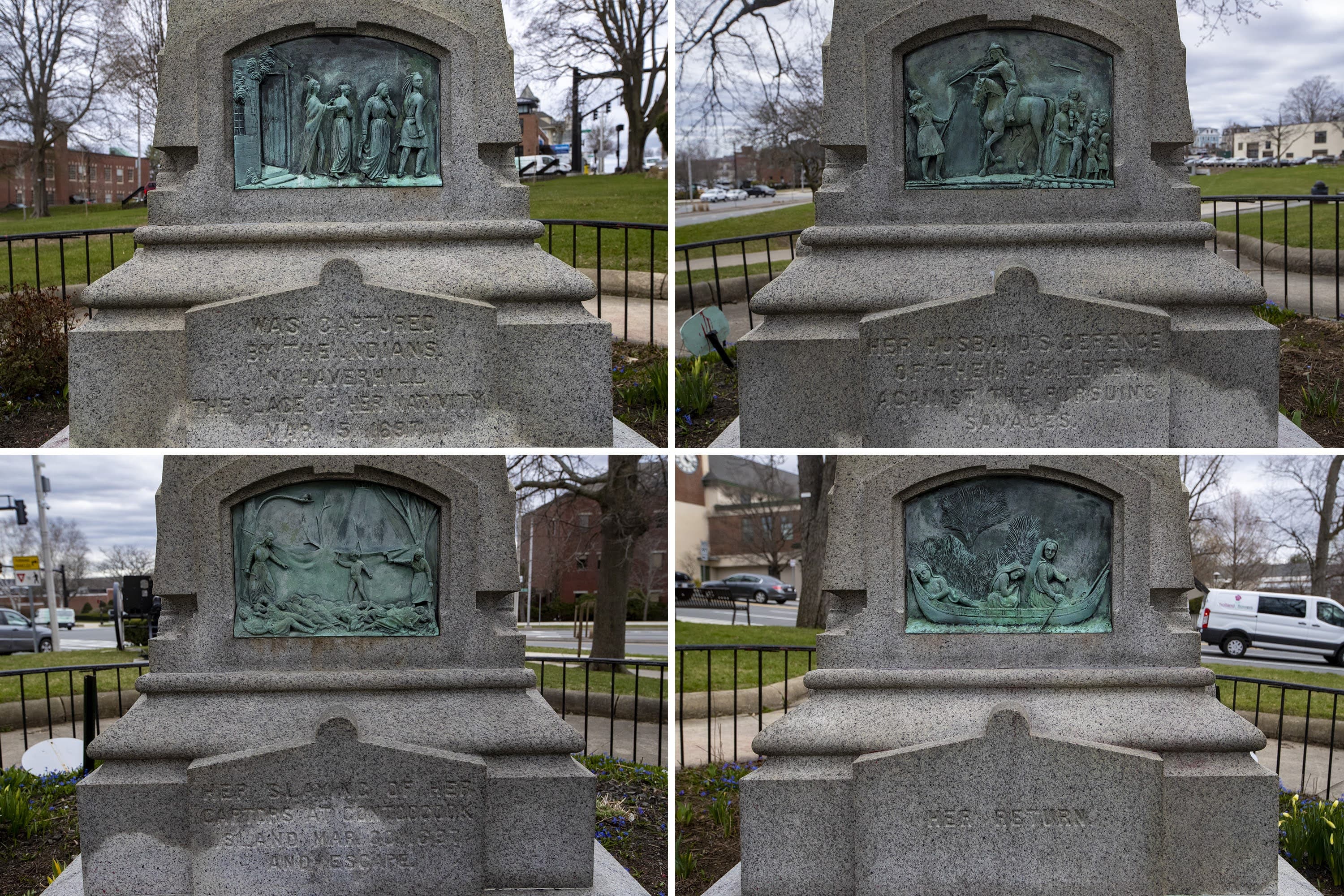
The first record of Duston’s account was written by the Puritan minister and author Cotton Mather. He described the murder of Duston’s baby in gruesome detail, writing that the “savages” “dash'd out the brains of the infant against a tree.” This detail became central to the Duston legend, providing both the motivation and the justification for the massacre, while the identities of Duston’s victims — four adults and six children — diminished.
Scholars have come to regard Mather’s account with skepticism. “We don't know for sure how the baby died, because if you look at that language, it's geared to present Native Americans as sort of unthinkingly violent savages,” Cutter says. “It's a very suspicious way of putting it.”
The Haverhill monument was erected in 1879 during a resurgence of interest in Duston’s story, at a time when the U.S. was aggressively expanding westward. The forced removal of Native people from their lands to make way for U.S. expansion sparked an anti-removal movement among 19th-century white Americans. Then, as now, the Hannah Duston monuments became the subject of scrutiny. “When we look at that statue of Hannah Dustin ... we can hardly help thinking that the whole thing is a farce,” wrote one concerned citizen, in an 1874 editorial in the Newburyport Daily Herald, of the Duston statue in Boscawen.
It is no coincidence that the Duston monuments went up when they did. “Her story could be used to represent the innocence of the colonists,” Cutter says. It is for this reason, she adds, that we shouldn’t dwell too much on what may or may not have happened in 1697, or attempt to make some definitive judgment on Duston’s actions.
“I think it's really more important to think about what people meant when they supported putting up this statue,” Cutter says. “And it wasn't about her. It was about an effort to hide the violence of colonization and imperialism.”
A Chance To Rewrite A ‘False Narrative’
An hour north of Haverhill in Boscawen, New Hampshire stands another Duston monument. The location — a small island at the junction of the Merrimack and Contoocook rivers — is supposedly the site of the massacre. Now it’s a neglected state park tucked behind a park-and-ride on U.S. Route 4.
The statue, which was erected in 1874, is thought to be the oldest memorial to a woman in the U.S. It stands about 30 feet high, its stone surface now vandalized with splatters of red paint, a cluster of miniature American flags planted at its base. The Hannah Duston of this monument wears a flowing gown and, in one hand, clutches a bundle of scalps that look like they could be flowers.

“She looks like that iconic Lady Liberty,” says Denise Pouliot. It’s a frigid afternoon in early April, and she and her husband, Paul Pouliot, have left their car at the park-and-ride and made their way across a rickety bridge to the monument. “With the Lady Liberty, it's always the same type of woman in the same type of dress, painting this nation as, you know, as a mother figure, as a nation of purity,” Denise says. “And that's not what's happening. This was oppression. This is a symbol of oppression.”
The Pouliots are the lead female and male speakers of the Cowasuck Band of the Pennacook-Abenaki People — essentially, the tribe’s co-leaders. Last year, as debates about the nation’s Confederate monuments reached a fever pitch, the Pouliots approached the New Hampshire Division of Parks and Recreation about the Boscawen monument. The couple now sits on an advisory committee tasked with redesigning the site.
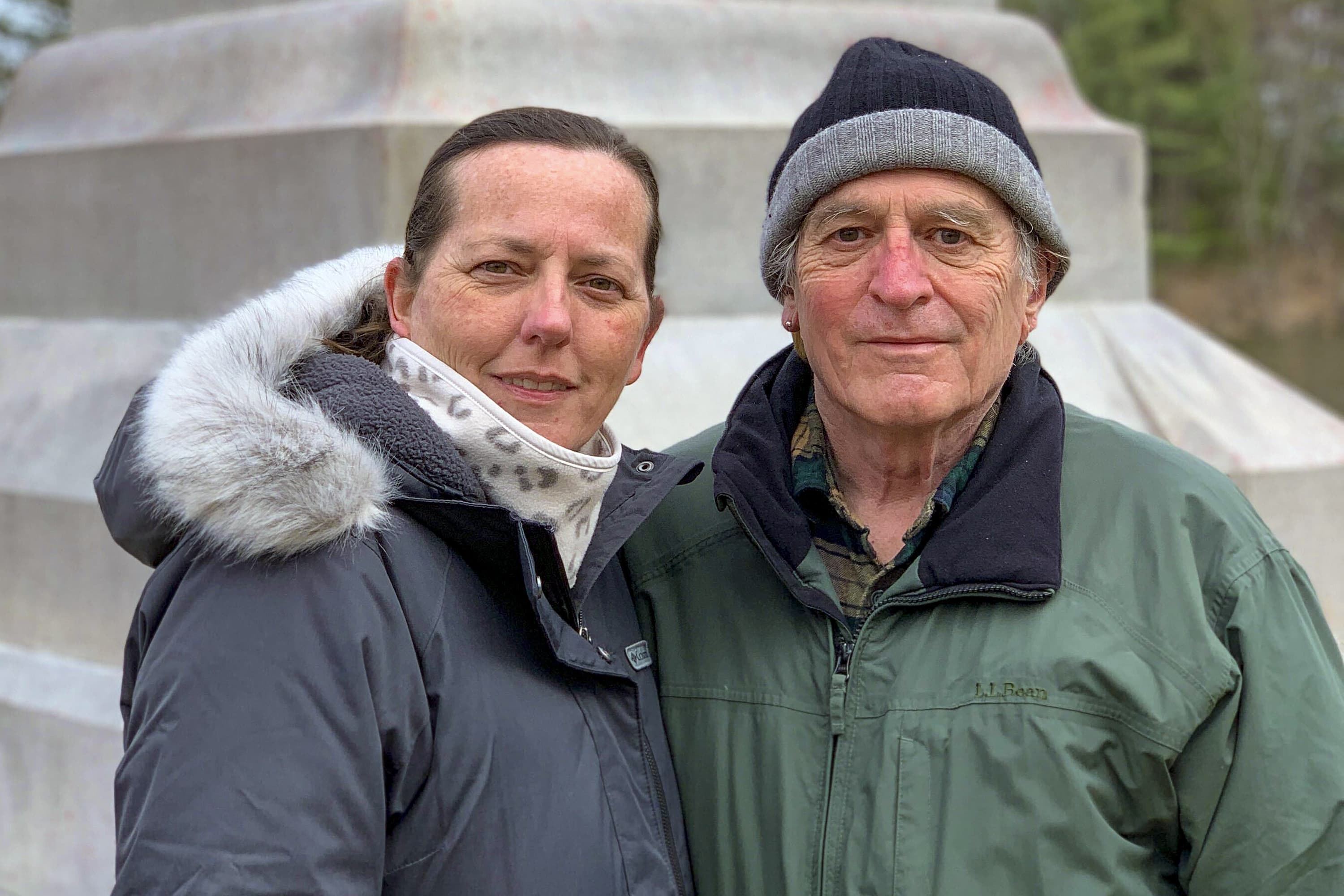
The committee is considering a number of alterations, such as “changing the signage, changing the name of the park,” says Craig Richardson, one of two members of the Duston-Dustin Family Association who serve on the advisory committee.
Richardson, who is the eight-times-great grandson of Hannah Duston, wants the statue to stay where it is, but believes a fuller story should be told. “I do believe she was both a victim and a killer,” he says. But, he points out, the statue was created to justify the colonial project. “The fact that her actions were used to help justify far worse is not is not a good thing. And the best way, I think, to help correct that is to try ... and help people understand exactly what happen[ed].”
Though they harbor no love for the monument, the Pouliots agree that the statue should remain in the park.
“On one hand, as an Indigenous person, we don't want a statue that honors Hannah, but on the other hand, we need an outlet in order to share the true history of the region,” Denise says. “How many historical books have been written based on this false narrative that I can no longer wipe off the shelves?”
Standing in the park, the Pouliots describe the changes they envision. There will be plaques about the Abenaki, maybe even a historical tour of the region accessible by smartphone. The park itself is in desperate need of rehabilitation. If they can raise enough money — and they’ll need a lot — they want to create a spot for swimming in the summer.
Primarily, though, they intend to build a memorial to Duston’s victims. “Now you don’t even have to make a statement,” Paul says. “You’re looking at something, it’s visual.” A memorial would speak for itself.
He can see it in his mind’s eye — a tableau of the family carved into a slab of granite. Two men, two women, six children. Ten anonymous Abenaki, who seemed to fade a little with each retelling of the famous tale, now brought into sharp, unforgettable relief.
This segment aired on April 28, 2021. The audio for this segment is not available.
